Kitchen Design Trends: Going Backsplash-Free
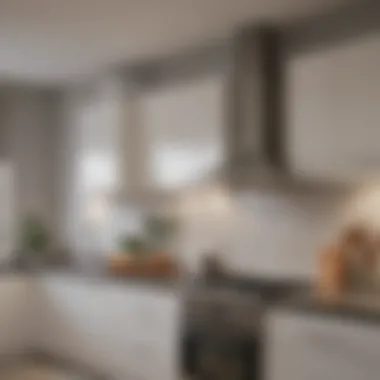
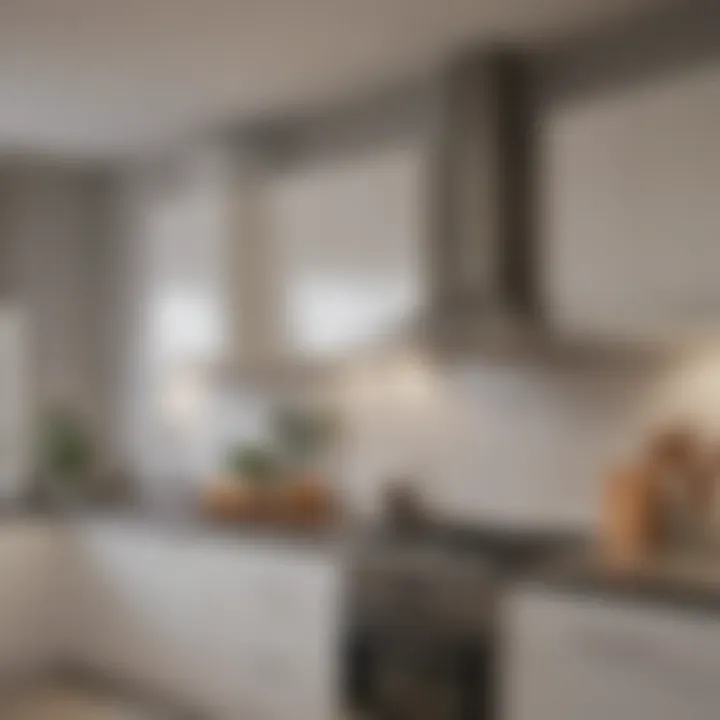
Intro
In today's kitchen design landscape, there's a fascinating shift towards forgoing the traditional backsplash, often seen as a staple in culinary spaces. This can stir quite the debate among design enthusiasts and homeowners. Is it practical? Do we sacrifice cleanliness for aesthetics? In this guide, we will delve into the implications of going backsplash-free, addressing aesthetic, functional, and maintenance concerns while also offering alternative solutions for enhancing your kitchen space.
Interior Design Tips
Trendy Design Ideas
So, you're thinking about ditching the backsplash? It might sound radical at first, but many modern kitchens have embraced this minimalist approach. Take a lead from Scandinavian design, where clean lines and functional beauty reign supreme. Using a solid color for your walls, such as a soft white or muted gray, can create an airy feel, mimicking the open space aesthetic.
Another tantalizing option is integrating your countertop materials into the wall. For instance, using polished concrete or elegant marble can create a seamless flow that’s both chic and easy to maintain.
Color Schemes and Combinations
Selecting a color palette that complements a backsplash-free kitchen is crucial. Consider the following:
- Monochromatic Schemes: Stick to one color but vary the shades. A range of blues can evoke calmness, while different greens might bring an earthy vibe.
- Bold Accents: If your base is neutral, why not throw in pops of color through kitchen accessories or decorative items? Just a few bright utensils or a striking wall art piece can add personality and contrast to your kitchen's design.
- Natural Tones: Earthy, warm tones can make the space more inviting. Think browns, terracotta, and muted greens which harmonize beautifully with wooden elements typically found in kitchens.
Furniture Arrangement Techniques
Without a backsplash, your walls become a blank canvas, and furniture placement becomes key to the overall aesthetic.
- Central Islands: Placing an island in the middle of the kitchen not only provides functionality but also serves as a focal point.
- Open Shelving: Walls without backsplashes give you the chance to use open shelving, showcasing beautiful dishware and adding depth.
- Strategic Lighting: Illuminate workspaces or emphasize wall art, having light fixtures only emphasizes the minimalist design approach of a backsplash-free kitchen.
"A well-arranged kitchen is a canvas of creativity, offering breathing room for culinary explorations and gatherings."
Maintaining coherence in your kitchen decor while skipping the backsplash requires thoughtfulness in design choices and details that reinforce the overall concept.
Alternatives to Enhance Aesthetic
As we explore kitchen aesthetics without the common backsplash, adopting unique wall textures or materials can add intrigue. Consider using materials like reclaimed wood or even textured paints that create depth without being overwhelming.
With the right design choices, a kitchen can speak volumes, becoming not just a cooking area but a thriving social space that effortlessly balances functionality with flair.
The Backsplash: A Historical Overview
When it comes to kitchen design, the backsplash has held a crucial role in both functionality and aesthetics for generations. Understanding the historical context of backsplashes adds depth to the current trend of designing kitchens without them. In essence, the backsplash has served as a shield between the wall and the chaotic activity that occurs in the kitchen. It offers protection from splatters and stains while adding character through various materials and styles.
Origins and Evolution
The concept of using a backsplash dates back centuries, with evidence found in ancient Roman homes, where vibrant mosaics adorned kitchen walls. These early iterations were not just for looks, as they played a significant role in protecting walls from smoke and heat during cooking. As time meandered through the ages, the necessity for a backsplash continued to evolve, adapting to the materials and technologies of the day.
Fast forward to the Renaissance, where kitchens saw an influx of decorative tiles. Ceramic tiles emerged as a common choice, capturing both art and practicality. As homeowners began focusing on aesthetics alongside functionality, backsplashes became a canvas for artistic expression. In the mid-twentieth century, the trends shifted again, with the introduction of modern materials such as stainless steel and glass that offered a sleek and contemporary feel.
Now, as we venture into the present day, the dialogue around backsplashes is shifting dramatically. There are those who embrace the trend of eliminating backsplashes entirely, citing cleaner lines and a minimalist approach as the appealing factors.
Purpose and Functionality
Traditionally, backsplashes were installed primarily for protection against spills and splatters from cooking. However, their role has expanded over the years. They not only safeguard walls but also contribute significantly to the overall design and ambiance of the kitchen.
The functionality of a backsplash is deeply intertwined with its design, transforming how we perceive kitchen space.
The materials chosen for backsplashes can change the felt atmosphere of the kitchen. For example, mirrors can create a spacious illusion, while darker materials can offer a sense of warmth and intimacy. The practical benefits extend beyond mere protection - they influence lighting, durability, and even acoustics within the room.
Characteristics such as ease of cleaning and resistance to staining depend on the material selected for the backsplash. In the era where time is a valuable commodity, a backsplash that is easy to maintain can deliver a considerable advantage to busy homeowners.
This exploration into the historical and functional aspects of backsplashes sets the stage for considering what happens when we forgo them. Can we still achieve a well-designed, functional kitchen? What alternative approaches emerge when we remove this traditional element? These are the questions that this article will dissect, aiming to equip homeowners and design enthusiasts alike with thoughtful insights into this evolving kitchen landscape.
Reasons to Consider No Backsplash
In exploring the modern kitchen design landscape, omitting the traditional backsplash has become a notable trend. It's not just a whim or fleeting fancy; rather, it's a deliberate push towards simplicity and flexibility in kitchen aesthetics. Homeowners and design enthusiasts alike are finding that a backsplash-free kitchen carries benefits that extend beyond mere visual appeal. Let's dig into the key reasons why this design choice is gaining traction.
Aesthetic Appeal
One of the most profound advantages of not having a backsplash is the clean and unbroken visual flow it creates. In a world where minimalism frequently reigns supreme, kitchens without backsplashes often present a more expansive and cohesive look.
Imagine a continuous surface stretching from the countertop up to the cabinetry—no interruptions, just pure elegance. This can open up smaller spaces, making them feel larger and less confined. Moreover, the absence of a backsplash invites a more daring alternative. Consider painting the walls in bold colors or using textured finishes, allowing you to express your personality without the confines of tiled or traditional materials. The design can cater to a range of styles, from the sleek, modern looks to rustic elegance, all while maintaining a unique flair.
Who's to say that a kitchen elbow-deep in the culinary arts can't also strut a bit of style? Without the burden of a traditional backsplash, homeowners can experiment with different materials and paint techniques that would usually clash with conventional backsplash designs. Variations such as mural art or metallic paint can act as stunning focal points that would be otherwise overshadowed by tiles. It adds a touch that could perhaps enchant or even shock the eyes of visitors, offering a refreshing departure from the norm.
Ease of Cleaning
When it comes to keeping the kitchen spick and span, simplicity often rules the day. By not having a backsplash laden with grout lines or grooves, cleaning becomes a breeze. Think about the hassle of scrubbing stubborn stains from those tiny spaces; it’s enough to drive anyone up the wall. Without this common feature, most surfaces, especially if they are painted or made from natural stone, can be wiped down quickly with little fuss.
In theory, one can use a damp cloth or a sponge with mild detergent and effectively remove splashes and spills without needing specialized cleansers for different materials. A straightforward approach to maintenance implies more time for culinary adventures—or maybe just a well-deserved cup of coffee.
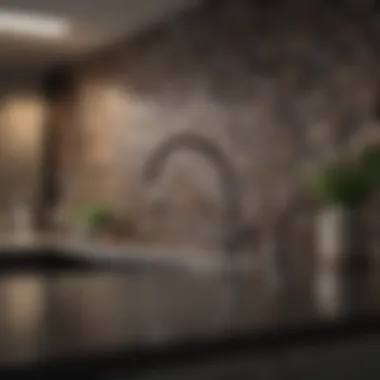
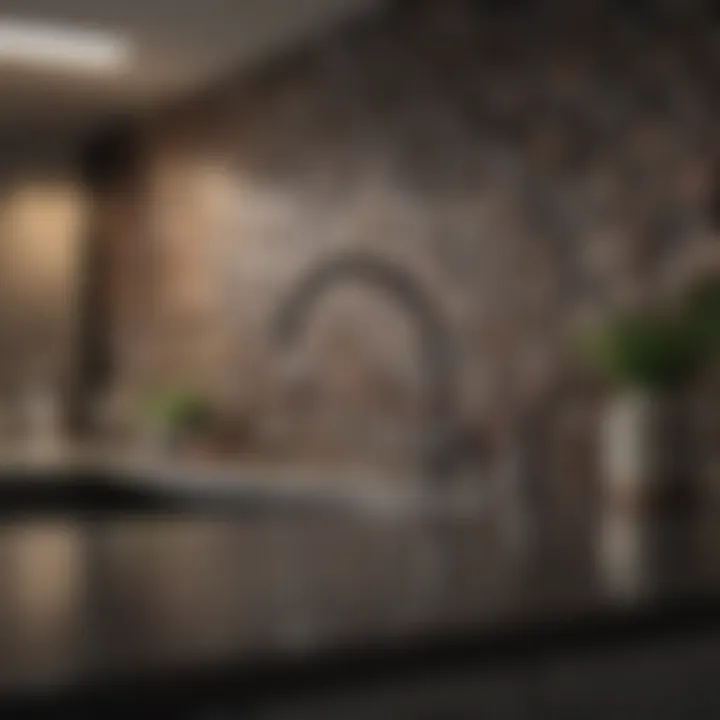
Moreover, in homes that frequently host gatherings, food splatters might be an everyday occurrence. Without a traditional backsplash, surfaces that endure the hustle and bustle become less of a cleaning savage. This adds further appeal, especially for those who enjoy entertaining guests and prefer less time spent cleaning up after culinary escapades.
Cost Efficiency
Cost considerations stretch far beyond just the materials used for tiling or design aspects tied to a backsplash. By eliminating this feature altogether, homeowners can save not only on initial renovation costs but also future maintenance expenses allied with traditional backsplashes.
Choosing no backsplash allows for the potential reallocation of funds towards more impactful upgrades, such as high-quality countertops or kitchen appliances. Instead of getting caught up in the minutiae of decorative tiles, investing in essential components can bring about a broader enhancement of the overall kitchen experience.
Homeowners can also find that not needing professional tiling services can be a delightful bonus. Renovating on a tighter budget becomes feasible, broadening access for all types of homeowners looking to revamp their kitchens.
"Less is often more, and embracing a simpler approach can lead to unexpected joys and improvements in design."
The potential savings don't just stop after installation; it extends to long-term maintenance. Reduced wear and tear on surfaces means less likely repairs or replacements down the road, helping maintain a kitchen that looks as good as new for many years to come.
In sum, for those daring enough to break the mold of traditional kitchen design, considering a backsplash-free approach opens a world of aesthetic appeal, ease of cleanup, and cost savings. This mindful design choice invites homeowners to think outside the box and redefine their kitchen spaces in transformative ways.
Design Styles Embracing No Backsplash
Omitting a backsplash in kitchen design opens up numerous possibilities. Various styles not only accommodate this design choice but also highlight the unique, clean aesthetics that can emerge. Homeowners who lean toward such modern approaches often find the absence of a backsplash helps create a sense of spaciousness. Not having a backsplash can give the kitchen a more fluid, open feel. Listeners to this trend include those who appreciate simplicity and intentional design.
Modern Minimalism
Modern minimalism stands as one of the leading design styles embracing backsplash-free kitchens. Characterized by clean lines, neutral tones, and a focus on functionality, this trend emphasizes the beauty found in simplicity. Instead of a tiled backsplash, a minimalist kitchen often showcases expanses of uninterrupted wall or innovative materials like quartz or polished concrete.
The use of textures becomes crucial in this setting. By allowing the materials of your countertops and cabinetry to speak for themselves, minimalism creates a calming atmosphere. Think of a sleek white countertop meeting a smooth painted wall—this creates visual continuity that is pleasing to the eyes. The luxurious nature of high-quality materials becomes a focal point, allowing them to shine without distraction.
Industrial Chic
Industrial chic design melds modernity with vintage elements, making it a standout style when avoiding backsplashes. In this approach, raw materials like exposed brick, concrete, and metal often take center stage. Notably, the beauty of an unfinished wall can add character, contrasting sharply with polished surfaces.
This style’s daring aesthetic opens up conversations about authenticity and history. For instance, a well-preserved brick wall can tell stories of a space's past, serving as a dramatic backdrop. Pair these walls with copper lighting fixtures and wooden accents, and you create an ambiance that feels both gritty and refined. It’s a balance that many homeowners desire, offering warmth without overwhelming the senses.
Rustic and Farmhouse
Rustic and farmhouse designs focus on natural materials and organic textures, making them perfect candidates for kitchens without backsplashes. Wood paneling, reclaimed barn doors, and handmade pottery introduce warmth and comfort.
Opting for a backsplash-free approach here means emphasizing the beauty of materials like weathered wood or exposed stone. This generates a cozy, inviting kitchen space. Imagine a wooden countertop that seamlessly extends to the walls, creating a unified, homely feel. It’s a style that promotes gathering and communal cooking, effectively turning a kitchen into the heart of a home.
Contemporary Elegance
Contemporary elegance encapsulates a timeless beauty while embracing modern trends such as forgoing backsplashes. This style often merges sophistication with minimalistic features. Clean surfaces and rich colors create visually striking contrasts without the need for additional patterns from tiles.
In this context, high-gloss surfaces might be used alongside muted wall colors to achieve a refined look. Think about deep navy cabinetry against ivory walls—there's a touch of class without unnecessary embellishment. Choosing high-quality materials like marble can elevate your kitchen's overall aesthetic while maintaining a sophisticated approach to design.
Materials That Complement Backsplash-Free Designs
In this modern age of kitchen aesthetics, the choice of materials plays a pivotal role. For those who dare to go without a backsplash, understanding how to harmonize their kitchen aesthetics becomes essential. The materials selected not only affect the look but also contribute to the functionality and maintenance ease of the space. Choosing the right materials can simplify cleaning routines and really highlight the overall design philosophy of the kitchen.
Natural Stone Surfaces
Natural stone surfaces like granite or marble can serve as a magnificent substitute for traditional backsplashes. Their elegance isn’t just skin deep; stone brings texture, depth, and uniqueness that synthetic materials often lack. Each slab of stone tells its own story, offering different veining and colors, giving character to your kitchen.
On the practical side, stone is incredibly durable. It can withstand the hustle and bustle of a busy kitchen. Even when splashed with water or spattered with sauce, a quick wipe works wonders. However, remember to seal them regularly to maintain their stunning appearance. For instance, using a product like StoneTech's BulletProof Sealer can protect against stains without changing the stone’s natural beauty.
Painted Walls
A painted wall is an often overlooked hero in a backsplash-free kitchen environment. It is undoubtedly one of the easiest ways to inject personality and flair into your cooking space. When selecting colors, think about hues that complement your cabinetry and countertops. Soft pastels can create a serene atmosphere, while bold shades can add a punch of energy.
"Color in the kitchen can set the mood. It's like the perfect wine pairing with a meal. It makes all the difference."
Painted walls also offer the benefit of easy adaptability. If your tastes change, a simple repaint can refresh the whole look without the hassle or expense of new materials. Just ensure you choose a kitchen-friendly paint that can resist stains and withstand the occasional splatter – a satin or semi-gloss finish usually does the trick.
Glass and Metal Finishes
The combination of glass and metal finishes adds an air of sophistication and modernity. Glass reflects light beautifully, expanding the perceived space in smaller kitchens and adding a sense of depth. You can consider back-painted glass as a lively alternative; it provides the clean look of glass while allowing for a range of colors to suit your design.
Moreover, metal accents—whether stainless steel or copper—can create a striking contrast against the softness of glass. Metal lends an industrial vibe while also being easy to clean; a quick wipe with a damp cloth often does the job. When combining these two materials, be mindful of cohesive design; they should complement rather than clash with each other.
Wood Paneling
Wood paneling can evoke warmth in the kitchen, presenting an inviting and rustic feel. Options such as reclaimed wood or shiplap are increasingly popular for kitchen designs that desire a backsplash-free look. Such materials create visual interest and texture, vital for breaking the monotony that can arise in larger wall expanses.
Furthermore, wood is versatile; it can be stained or painted to harmonize with cabinets and furnishings. However, it’s important to use treated wood or specific coatings that can withstand moisture and spills. For instance, consider using waterproof finishes like marine varnish to ensure longevity and durability in the kitchen environment.
In all, integrating these materials into a backsplash-free kitchen isn't only about aesthetics—it's about creating a space that is functional, easy to maintain, and perfectly aligned with your personal style. Choosing wisely allows homeowners to break free from convention while still enjoying a stylish and practical kitchen.

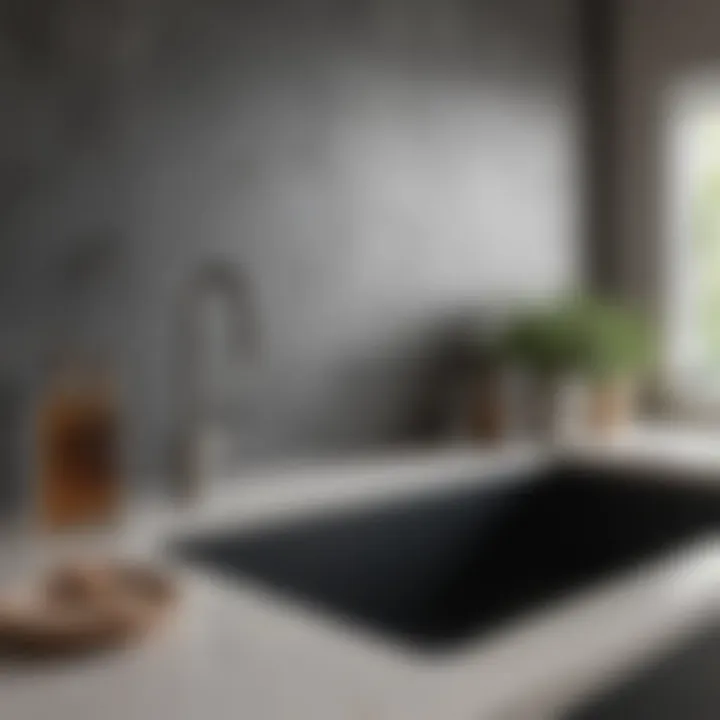
Maintenance Considerations
In the realm of kitchen design, the absence of a backsplash can stir a mix of curiosity and skepticism. Understanding how to maintain a kitchen devoid of this traditional feature is crucial. Maintenance considerations not only evoke the practicality of kitchen usage but also provide insight into how homeowners can balance aesthetics with functionality.
Cleaning Practices
Cleaning a backsplash-free kitchen might seem like a walk in the park, yet it does come with a set of distinct practices that can help keep the space spick and span. For instance, the walls can be directly exposed to grease, food splatters, and smoke from cooking. Therefore, utilizing the right cleaning agents becomes important to ensure surfaces remain pristine without damaging the material.
Here are some practical cleaning tips for a backsplash-free kitchen:
- Choose Your Cleaner Wisely: Opt for non-abrasive cleaners that suit your wall material. For instance, if it’s painted drywall, gentle soap solutions can work wonders while avoiding harsh chemicals.
- Damp Cloth Trick: A damp microfiber cloth can be your best friend. Not only do they trap dirt and dust, but they can also tackle most minor spills without scratching surfaces.
- Establish a Routine: Regular cleaning prevents build-up, making the occasional deep clean far easier. A quick wipe-down after each meal can do wonders for tidiness.
Furthermore, incorporating a maintenance schedule preemptively addresses potential cleaning challenges, simplifying the upkeep of your kitchen's aesthetic and hygiene.
Potential Damage from Cooking
Even the best chefs in the world can cause a mishap or two in the kitchen, and when there's no backsplash, those cooking follies can lead to unfortunate consequences. The lack of a backsplash exposes the wall surfaces to potential risks such as heat, moisture, and food debris. Understanding how these factors interplay is vital for homeowners considering a no-backsplash design.
Here are some points to keep in mind:
- Heat Exposure: Cooking appliances can generate substantial heat. Wall surfaces, if not shielded correctly, may suffer from discoloration or warping. It might be wise to assess which wall materials are heat resistant, preventing unsightly marks or permanent damage.
- Moisture Concerns: Damp cooking can lead to moisture accumulating on walls. This should raise some eyebrows for anyone who’s experienced the wrath of mold elsewhere in the home. Regularly inspecting these areas and ensuring good ventilation helps mitigate such issues.
- Spills and Stains: Food or liquids might accidentally find themselves on walls in the heat of the moment. Clean-up during or immediately after cooking is ideal to prevent lingering stains. Here, using washable paint or wipe-able wall treatments can serve as a protective measure.
"Maintaining a backsplash-free kitchen requires vigilance; a little tender loving care can go a long way in preserving your design choice."
Awareness of these maintenance considerations ensures that the beauty of a backsplash-free kitchen design shines through, without compromising functionality. With mindful practices, homeowners can enjoy the sleek and modern look of their kitchen while keeping it in shipshape condition.
Visual Enhancements for Backsplash-Free Spaces
When considering a kitchen design without a backsplash, it's crucial to think carefully about alternative visual enhancements. A backsplash often serves as a focal point, bringing life and texture to the area behind the counter. However, for homeowners and design enthusiasts looking to break the mold, embracing this new style offers an opportunity to express personal tastes through other design elements.
Artwork and Wall Decor
Adding artwork or unique wall decor in a backsplash-free kitchen can elevate the space significantly. Consider experiences from homeowners who have hung large, eye-catching prints or even a series of smaller framed pictures that reflect their personalities. For example, a vibrant painting might draw the eye, pulling focus away from the empty wall behind the sink, while introducing color and life to the area.
Moreover, ceramic plates, woven tapestries, or even a collection of antique kitchen tools displayed can create a charming, personalized narrative in your kitchen. These elements not only enhance visual interest but also provide a comfortable backdrop for daily activities. By thoughtfully selecting decor that resonates, you can turn an otherwise overlooked space into a key feature of the kitchen.
Color Schemes and Paint Techniques
Choosing the right color palette for your walls can make a lasting impression. Without a backsplash, the wall color takes center stage. A bold hue like deep navy or rich emerald can create a striking contrast against white cabinets and countertops, forging a contemporary look.
On the other hand, using soft pastels may evoke a light and airy feel, perfect for those seeking tranquility in their cooking space. Additionally, exploring painting techniques like ombre or a sponge finish can add depth and character, making your wall a true centerpiece of the kitchen without a traditional backsplash.
- Considerations for Color Choices:
- Lighting: Understand how natural light affects color choices throughout the day.
- Coordination: Ensure that your palette works well with your cabinetry and appliances.
- Personal Preference: Don't shy away from colors you love, as your kitchen should reflect your style.
Lighting as a Design Element
Lighting plays a pivotal role in highlighting the features of a backsplash-free kitchen. Without a backsplash to reflect light, carefully selected lighting fixtures can draw the eye upwards and illuminate the room. Pendant lights or sconces can enhance the ambiance and create functional zones within the kitchen.
Consider adding under-cabinet lighting to brighten your workspace, making it both stylish and practical. This allows your wall color and decor to be showcased dynamically, bringing warmth and character to the kitchen.
"Lighting transforms an ordinary kitchen into an extraordinary space, showcasing design choices while making it livable and inviting."
In summary, while the absence of a backsplash can seem daunting, there are many avenues to explore through artwork, colors, and lighting. Each element can add depth and personality, ensuring your kitchen is both functional and a true reflection of your style.
Kitchen Layouts That Favor No Backsplash
In the realm of kitchen design, opting out of the traditional backsplash requires careful consideration of layout. The layout itself becomes a pivotal element, influencing not just the aesthetics but also the functionality of the space. Without a backsplash, kitchens become more open and fluid, allowing for a seamless connection between culinary and social activities. It’s imperative to select a layout that not only accommodates the absence of this design feature but also enhances the kitchen experience overall.
Open Concept Designs
Open concept kitchens have gained significant traction in modern homes, encouraging interaction between the kitchen, dining, and living spaces. This layout promotes a sense of community, making it an ideal candidate for a backsplash-free design. Without physical barriers, the area can feel more spacious and inviting.
In this type of design, consider elements that reflect light and maintain a sense of warmth. Here are some key points to enhance this concept:
- Flow and Functionality: The lack of a backsplash allows for easier navigation and movement within the space. Users can transition smoothly from cooking to dining without a visual or physical interruption.
- Unified Aesthetic: Using consistent materials—like wood or natural stones—across counters and walls can unify the space, creating a visually pleasing effect. This can replace traditional borders that backslashes provide.
- Strategic Lighting: Lighting becomes even more crucial in an open concept kitchen. Utilize both ambient and task lighting to define spaces and highlight design elements, making the room feel airy and bright.
Ultimately, open concept designs thrive without a backsplash, fostering an environment that encourages connection and creativity in cooking and hosting.
U-Shaped and L-Shaped Kitchens
U-shaped and L-shaped kitchens offer a different approach while embracing the no backsplash concept. Each layout presents unique advantages and considerations, particularly in relation to space and efficiency.
For the U-shaped kitchen, the configuration promotes a natural workflow, often keeping everything within arm's reach. This is particularly beneficial when eliminating a backsplash:
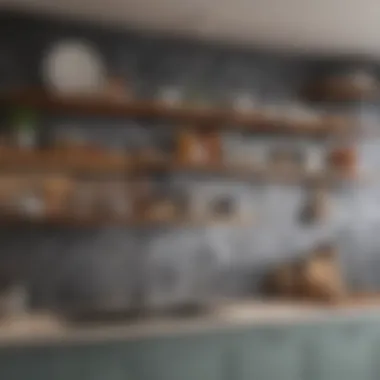
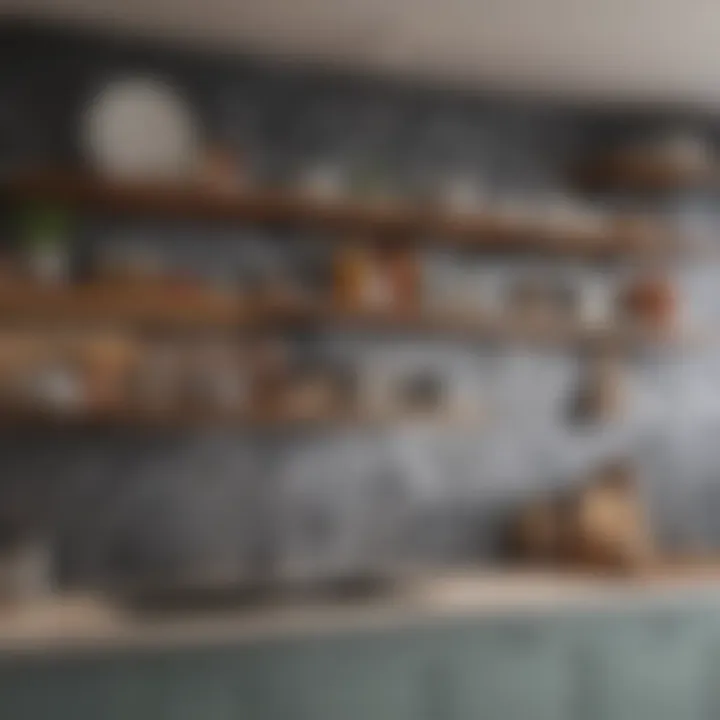
- Accessibility: The shape allows for easy movement between various kitchen points—sink, stove, and refrigerator—minimizing trips across the kitchen while cooking or prepping.
- Visual Continuity: An uninterrupted wall surface gives it a clean and streamlined look. You may go for colors that either contrast or complement countertop shades, enhancing the kitchen's overall visual appeal.
In contrast, the L-shaped kitchen can efficiently utilize corner space while being flexible for different designs. Here are a few aspects to consider:
- Customization Options: Without a backsplash, homeowners can use creative wall finishes or paint techniques to add character. This allows individualized expression while maintaining the functionality of the design.
- Zone Delineation: This layout can subtly define functional zones without the need for intricate design elements. For instance, paint or varying textures can differentiate cooking areas from social zones.
In both U-shaped and L-shaped kitchens, thinking beyond traditional design rules can lead to remarkable solutions that still feel complete and inviting despite the absence of a backsplash.
It becomes clear that kitchen layouts play a crucial role in determining how well spaces can adapt to a backsplash-free design, underscoring the importance of options like open concepts and configured layouts.
Comparing Costs: Backsplash Versus No Backsplash
When it comes to kitchen design, the decision to have or not have a backsplash carries significant implications, particularly on costs associated with both initial installation and long-term maintenance. Homeowners are becoming increasingly curious about minimizing expenses without sacrificing style or functionality. Not having a backsplash does not just represent a trend; it prompts advanced considerations regarding the overall budget of a kitchen remodel.
Initial Installation Costs
Opting for a backsplash-free kitchen often leads to lowered initial installation costs. Installing a backsplash can demand considerable time and investment in materials, such as tiles, glass, or stone. Each of these materials has its own price point and labor costs associated with proper installation.
When bypassing the backsplash, you're primarily investing in wall finishes that can be simpler and more cost-effective. For example, painting is often much cheaper than purchasing tiles, not to mention the labor costs associated with cutting and fitting each tile.
- Materials to Consider:
- Paint: Average of $20-$50 per gallon.
- Wallpaper: Could range from $30-$150 per roll.
- Wood Paneling: Prices can vary but are often in the range of $15-$30 per square foot.
Moreover, the artistic freedom of the wall itself allows for a variety of options, which can dramatically affect the overall feel of the kitchen without straining the wallet.
"Going for a no-backsplash design might surprise you with the savings in your remodeling expenses."
Long-Term Maintenance Costs
Just like the initial costs, the long-term maintenance costs associated with a backsplash versus no backsplash can further sway your decision. Tile backsplashes typically require rigorous cleaning and maintenance. The grout lines, for instance, tend to stain and can easily accumulate dirt and grime over time, necessitating periodic resealing or scrubbing. This ongoing effort translates into more frequent cleaning, which can consume both time and cleaning supplies.
In contrast, a backsplash-free design can dramatically reduce long-term upkeep. The lack of grout lines means fewer areas for dirt to settle. If a painted wall is used, it can be wiped clean without concern for damaging grout. So, in essence:
- Less Frequent Cleaning: Keep things spick-and-span without the fuss.
- Reduced Product Costs: Less reliance on specialized cleaning supplies for grout can save bucks over time.
Making an informed choice about your kitchen design involves more than just immediate finances. Reflecting on both installation and maintenance costs will help you calculate a clearer picture of what a backsplash-free kitchen can offer in the longer haul. In summary, while the initial appeal might steer you towards conventional setups, the practical reality might just tilt the scales towards a more innovative, backsplash-free approach.
Expert Insights and Recommendations
When delving into the realm of kitchen design sans a backsplash, it becomes paramount to gather thoughts from those steeped in the industry. This section explores essential insights from designers and real homeowners, highlighting the numerous dimensions of opting out of conventional backsplash installations. The benefits extend beyond mere aesthetics, as considerations about usability, maintenance, and personal style preferences come into play. Having knowledgeable voices lends credibility and depth to the topic, illuminating the paths homeowners may take towards a stylish yet functional kitchen.
Designer Perspectives
The thoughts of designers provide a rich tapestry of creative options and practical advice when it comes to kitchen designs without a backsplash. Many modern designers advocate for the idea that a backsplash can sometimes crowd a space, especially in smaller kitchens. They emphasize the open, airy feel that a backsplash-free area can create. For instance, interior designer Lila Morgan mentions, "Eliminating the backsplash allows my clients to see more of their stylish paint colors and wall finishes. A clean slate can serve as a canvas, where the functionality of the kitchen plays center stage."
Furthermore, designers suggest exploring various materials that can elegantly replace or compensate for a traditional backsplash. These include:
- Natural stone surfaces that offer durability while still being visually striking.
- Painted walls in bold colors that can enhance mood and energy in the kitchen.
- Textured wall coverings like wood paneling that add depth and warmth, drawing the eye upward.
- Glass or metal finishes that catch the light and create a sense of space.
They often recommend considering not just design aesthetics but also functionality; for instance, ensuring that chosen materials are easy to clean and maintain. Ultimately, designers underscore that leaving out the backsplash should be a thoughtful choice reflecting both personal style and practical living.
"A well-designed kitchen sans backsplash can be a joyful blend of simplicity and sophistication," says designer Clara Faith.
Homeowner Experiences
Homeowners who've taken the leap into backsplash-free designs frequently share transformative stories. Many express a newfound appreciation for the flexibility this design choice affords. When Sarah Wong remodeled her kitchen, she reflected, "After removing the traditional backsplash, my kitchen felt bigger. I could switch up colors on the wall easily, matching the season or my mood. Plus, it simplified cleaning—just wipe the walls down instead of scrubbing tiles!"
Positive results often stem from either forced decisions due to budget constraints or personal tastes. Many homeowners noted:
- Cost savings on materials and installation, making it a smart choice from a financial standpoint.
- Simplicity in color matching, allowing for artistic expression through paint or cabinetry.
- A sense of coherence and flow between spaces, particularly in open concept designs where the kitchen merges with dining or living areas.
However, the experience isn’t entirely blissful; some homeowners voiced concerns about potential damage from spills and cooking. Mindful preparation, like applying durable paint or choosing higher-quality materials, often alleviates these worries. Hence, their collective wisdom serves as a cautionary tale, prompting future renovators to think ahead.
In summary, expert insights and personal experiences underline the benefits and considerations of moving away from traditional backsplashes. The choice is as much about celebrating individuality in design as it is about functionality and lifestyle adaptation.
Closure: The Future of Kitchen Design
The landscape of kitchen design is changing, and the absence of a backsplash is at the forefront of this shift. This article dives into the implications of moving away from traditional kitchen features, particularly the backsplash. As homeowners and designers seek to blend aesthetics with functionality, embracing a backsplash-free design opens up new avenues of creativity and practicality.
A Shift in Design Philosophy
In recent years, many designers have noticed a gradual shift in how people perceive kitchen spaces. Instead of viewing kitchens solely as places for cooking and preparation, they are now seen as an extension of the home. This change in mindset fuels the desire for kitchens that resonate with personal stories and styles. A backsplash often imposes limitations on this personal expression. By removing this barrier, homeowners can play with textures and colors that speak to their tastes without compromising functionality.
Moreover, as trends lean toward minimalism and simplicity, leaving walls bare or painted invites more of a personal touch than a uniform tile display.
Innovative Approaches Moving Forward
As we look ahead, several innovative approaches emerge that align with a backsplash-free kitchen design.
- Embracing Natural Materials: Moving forward, natural materials like wood and stone continue to gain traction. These materials create warmth and texture while requiring less maintenance than traditional tile backsplashes.
- Technology Integration: The kitchen of the future will likely feature smart technologies that can assist in cleaning spills or managing temperature around cooking areas. Imagine surfaces that can repel stains or easy-to-clean finishes, meaning splashes and splatters become less of a concern.
- Dynamic Lighting Solutions: Innovative lighting can play a vital role in enhancing kitchen aesthetics. Think accent lights or under-cabinet installations that can transform spaces dynamically without the need for traditional surfaces.
In summary, the future of kitchen design is not just about the absence of backsplashes; it’s about rethinking and reshaping how space is utilized. By exploring different materials and techniques, homeowners have the opportunity to craft kitchens that reflect their individuality while remaining practical.







